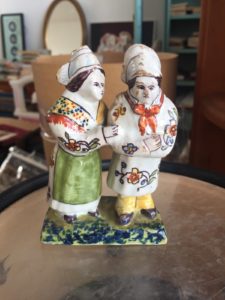 GC showed me this little figural sculpture, about three inches tall. Ugly? Misshapen? Amateur? No! This is an old piece, French, early 19th century, and worth about $300 in perfect shape.
GC showed me this little figural sculpture, about three inches tall. Ugly? Misshapen? Amateur? No! This is an old piece, French, early 19th century, and worth about $300 in perfect shape.
The piece is called Faience by the antique world of pottery collectors, and faience is exceptional. it’s comprised of tin glazed pottery on buff earthenware bodies. Faience, in its elemental form, has a white glaze that can be painted. This very old technique comes originally from Persia in the 9th century where potters developed a kiln that heated to over 1000 degrees. Through Italy, the tradition was brought to France in the 16th century, where it’s still a collectible material in all forms, from table wear to figurines.
Many countries made faience:
- Delft in Holland
- “frit” in ancient Egypt
- Creamware or Lusterware in England
- Talavera in Mexico
But the French mastered the style, and still do so. In ONE museum, the Musee de la Faience de Marseille, you can see the traced history of faience.
You will see beer steins in faience. But my favorite faience are the large apothecary jars made in France or Italy with the Latin inscriptions of drugs and plant herbal remedies. When I started my career in Britain in the 1970’s I collected the folk faience of England called Staffordshire figures from the 19th century. You will recognize the “pug dogs” for the mantelpieces of that style.
The history of faience tells the history of the conveyance of culture
Only China, before 1770 or so, knew the secret to making PORCELAIN. Europe only imitated the look of a white slip of porcelain, hand painted, by taking buff earthenware and PAINTING it white. THEN they painted a design over the white. Thus the origin of the Blue and White Delft.
Dutch potters didn’t want to lose all their business to the export shipping trade in porcelain from Canton in China, the great port where porcelain was made and exported to Europe in the 17th and 18th centuries. So they made something that from a distance looked like porcelain. Not until Meissen found the secret chemical ingredients in porcelain did Europe have a porcelain center. Still faience continued in popularity because of its durability and affordability.
The potters on the island of Majorca became the finest makers of faience early on, late medieval period, called Maiorica, because of trade with the Moors who brought pottery to Spain. That’s what I mean by cross-cultural current. We often think we in the 21st century have the monopoly on a global material culture. But faience was one of the first global cultural phenomena from the 14th century. The technique first got exported into Spain, then into France, who made it a countrywide manufactory.
GC has a piece from the factory in Nevers, considered a folksy traditional type, there’s also the great Quimper faience that is always associated with Country French Living. You’ll see that pottery in strange colors to our eyes, especially the mustard green backgrounds, but you’ll also find country girls and boys on white pottery painted in blues and reds from Quimper. Many people collect Quimper for a French Country kitchen, and hang it upon the walls.
Strange to think but faience came to California via the California School of Arts and Crafts in Berkeley from 1915-1959. Have you visited Hearst Castle? You will find California Faience on the roof and trailing down the turrets, because architect Julia Morgan commissioned the tiles from the founders Bargdon and Thomas in the 1920’s. There’s still a hint of Spain in these tiles, whether they were used architecturally or decoratively. Tile and California has been inseparable ever since, although you must remember the tradition comes straight out of the Middle East through the Moors into Spain. Tableware and figures are more likely French, blue and white faience usually Delft or Gouda. You will find it all heavy, a little primitive, and amateurish looking, but delightful and whimsical.
Many fine residences in Santa Barbara have faience tiles whether framed in a vignette or incorporated into architecture. This is a style dear to the heart of Santa Barbara, and is highly collected for Spanish Colonial homes. GC has a price tag of $3 on it in his shop. Time to raise the price slightly before I buy it!